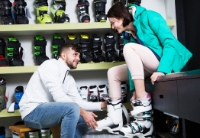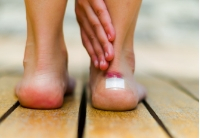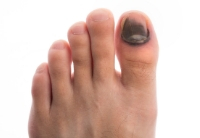Preventing foot problems when skiing or snowboarding seems a difficult challenge!
In the cold, muscles take longer to warm up and so you are more prone to muscle and ligament injury or strains when skiing and snowboarding. In skiing particularly your feet act as a shock absorber and brake as well as helping you steer and accelerate so it is important to wear the correct equipment and look after your feet appropriately during your time on the slopes.
Lets look at how we can prevent foot pain when participating in this adrenaline filled sport!
A lot of my patients seem to be going on skiing and snowboarding holidays at the moment – I’m very jealous! I have never been skiing but it is always been on my “bucket list” of things to do – although I’m sure I would chicken out when I got there! I thought I would look at what can go wrong with your feet when skiing (other than the obvious falls, breaks and fractures) and how to avoid them.
Ski equipment
I’m sure, many of you who ski or board frequently may have your own equipment but is it the right equipment and does it offer you enough protection from injury? Equipment is the main key in prevention of foot injury when skiing and snowboarding. Let’s take ski boots first, a must for anyone on the slopes!
Ski boots

I’ve heard many a story about problem boots and I’m sure many of you have/will learn the hard way that ill-fitting ski boots can lead to a whole array of problems! Ski boots must be a snug fit – too loose and the foot and ankle slides around and can lead to sprains, strains and fractures. Be aware though, too tight and they can rub and blister the foot. To check the fit, kick your heel and then your toe against the ground while wearing your boot. If your foot slides backwards and forwards, the boot is probably too loose.
The boots must be rigid enough to keep your feet and ankles firmly in place, especially the heel, but should allow your ankle to flex. The area where your toes sit (the toe box) should be snug but not too tight. A good test is when in the boots lean back: your toes should just skim the front of the boot.
Top Tip!
Remember that you will be wearing your boots for around seven hours a day while skiing, so they must be comfortable. Choose boots carefully, trying on a number of models and wearing them around the shop before you make your choice. When you try on the boots ensure you are wearing the socks you plan to wear skiing or boarding as changing these may alter the fit of the boot enough to cause a problem.
Socks
Socks are not only important as they keep your feet warm in the snow but they also help to keep the boots comfortable. These days there are socks designed for skiing or boarding help to stop excess moisture. Socks don’t need to be thick – in fact as podiatrists we recommend thinner socks and to avoid layering them up. Some more specialist socks also add cushions for ankle bones and the bottom of your feet.
Blisters and bruises

While these sound like very minor problems, knocks and blisters can keep you off the slopes while they heal and eat into your precious holiday time. They are also probably one of the most common complaint podiatrists and chiropodists hear about from patients who report foot problems associated with skiing and snow-boarding. In-fact they are probably the most easily avoided with a decent pair of ski boots correctly fitted and the correct socks.
It is worth noting not everyone has the most perfect of foot shape and lumps and bumps can irritate. If your foot has some bony bits that you think may rub you can protect these with plasters such as compeed or fleecy web which stay on better than normal plasters and provide longer protection. The most common areas to blister or bruise in a ski boot are the ankle bone, toes, top of the foot and front of the shin. Avoiding moisture in the skin will also help to avoid these.
What do you do if you get a blister?
Do not pop a blister, but if it breaks on its own, apply an antiseptic and cover with a sterile bandage. If you know you are prone to blistering in a particular area, some skiers advise applying a dab of Vaseline to the area in question before starting to ski as a preventative measure. It is worth taking Vaseline and blister plasters such as compeed with you as a precaution. If you return with a blister seek advice from a podiatrist who can drain the blister in a sterile environment and manage the wound underneath.
Damaged toenails

Most people tend to find one or more toenails go black whilst skiing. This is usually bruising under the nail and often caused by pressure such as boots being too tight or your foot moving around too much in the boot. Bruising of the nail will unfortunately remain until the nail has grown out – sometimes up to 12 months in the case of the big toe! On occasion, as your new nail grows under the bruised nail this may push the damaged nail off and it will appear you are losing the nail. If this happens it is best to seek help from a podiatrist or chiropodist to cut the nail back safely and smooth off any rough edges which may be prone to catching on socks etc. In some cases, this damage to your toenail(s) may result in more permanent damage such as thickened nails or ingrowing toenails.
Other foot conditions
Other conditions, such as diabetes or Raynaud’s Syndrome, which both affect circulation and are made worse by cold and tight-fitting footwear and have to be carefully monitored when skiing. The best advice is to consult your podiatrist before you hit the slopes.
Chilblains are itchy blisters that can pop up in cold conditions, usually on the toes but also on fingers and even on the face. Again, keeping the areas warm and dry is the best way to prevent them.
Our podiatrist’s top tips to prevent foot problems when skiing
1. Choose the right boots – this is essential, so don’t rush it! Try our tips above for checking the fit of your boots.
2. Wear one pair of thin socks designed for skiing – don’t layer, and don’t wear cotton socks.
3. Take a first aid kit with you that contains plenty of blister plasters, Vaseline etc
4. Don’t tuck your trousers into your boot.
5. Protect bony prominences which may rub.
If you are off skiing or snowboarding – have fun and look after your feet – you will enjoy the trip more if you do! If you have been skiing or snowboarding and have any problems with your feet contact us today to see how we can help.


